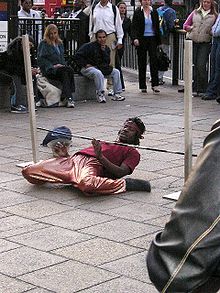Limbo (dance)
This article needs additional citations for verification. (November 2009) |
This article may require copy editing for grammar, style, cohesion, tone, or spelling. (April 2013) |

The Limbo dance originated as an event that took place at wakes in Trinidad and Tobago, and was popularized by dance pioneer Julia Edwards (known as the First Lady of Limbo) and her company, which appeared in several films, in particular "Fire Down Below"[1] (1957), and toured internationally in the 1960s and beyond. A film "Julia and Joyce"[2] was released in 2010 by Trinidadian/American dance researcher/choreographer Sonja Dumas, and features the evolution of the Limbo and the contribution of Julia Edwards to the explosion of its popularity.
Limbo is unofficially considered the national dance of Trinidad and Tobago, which refers to itself as the Land of Limbo, steelpan (steel drums) and calypso. After a preparatory dance, the dancer prepares and addresses the bar, lowering and leaning back their body while balancing on their feet, with knees extended forwards. The dancer is declared "out" and loses the contest if any part of the body touches the stick or pole that they are passing beneath, or if the hands touch the floor. When several dancers compete, they go under the stick in single-file; the stick is gradually lowered until only one dancer, who has not touched either the pole or the floor, remains.
Limbo is a movement that is traditionally done at funerals and derives from the African legba or legua dance. If the dancer easily makes it under the bar, it means that the spirit has transitioned to the other side with equal ease. Traditionally, the bar began at the lowest possible height and was gradually raised, signifying an emergence from death into life. In its adaptation to the world of entertainment, troupes began reversing the traditional order. Julia Edwards is considered responsible for adding a number of features that are now seen as standard, such as human 'bars' formed by the limbs of other dancers, and the use of fire in the performance of Limbo.
When American and British sailors returning from the island of Trinidad took the form back to their home countries as a party dance, it began to gain popularity, and pop music using Caribbean rhythms emerged in response to the craze. One major example is the song "Limbo Rock" recorded by Chubby Checker), from which originated the popular chant "How low can you go?", that became synonymous with limbo. Limbo was also brought into the mainstream by Trinidadian Calypsonian, Brigo (Samuel Abrahams) with his popular soca song "Limbo Break".
As Limbo spread out of Trinidad and Tobago to the wider world and the big screen, Limbo became a major part of the tourism package in several other Caribbean islands, such as Barbados and Jamaica. The term could also be widely heard in 1950s Jamaican mento, not directly related to the Limbo dance theme. Examples include "Limbo" by Lord Tickler and Calypsonians, and the identically titled "Limbo" by Denzil Laing & The Wrigglers. Limbo is still practiced by numerous dance troupes in Trinidad and Tobago, especially during the Prime Minister's Best Village Competition, and the Carnival.
In recent years, limbo dancing has been conducted as a social "icebreaker" game for tourists at Caribbean and other tropical resorts. It is also a popular game at roller-skating rinks, with the dancers on roller skates. The winning dancer often receives a prize.
History
The word 'Limbo' is used to denote a form of dance that dates back to the 1950s. Merriam–Webster [1] lists the etymology as a Trinidadian English derivative of 'limber', meaning supple or flexible. The name may also refer to the Roman Catholic spiritual state of limbo. "Consistent with certain African beliefs, the dance reflects the whole cycle of life".[3] "The dancers move under a pole that is gradually lowered from chest level, and they emerge on the other side, as their heads clear the pole, as in the triumph of life over death".[3]
World Record
The world record for lowest Limbo dance is held by Shemika Charles, an 18-year-old woman from Trinidad who lived in New York. On 16 September 2010 she successfully danced under a bar only 8.5 inches (21.5 cm) above the ground. [4]
References
- ^ Fire Down Below
- ^ Julia & Joyce: Two Stories of Two Dance Pioneers
- ^ a b Stanley-Niaah, Sonjah. "Mapping of Black Atlantic Performance Geographies: From Slave Ship to Ghetto." In Black Geographies and the Politics of Place, ed. by Katherine McKittrick and Clyde Woods, 193-217. Cambridge, MA: South End Press, 2007.
- ^ http://www.worldrecordsacademy.org/society/lowest_limbo_by_a_woman_world_record_set_by_Shemika_Charles_101874.html
